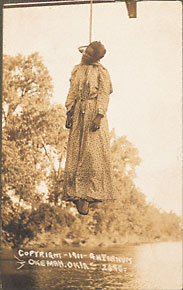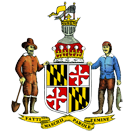| Research and Educational Projects at the Maryland State Archives |
|
| 02-intro |
|
|
| Contact the Department of Special Collections for location. |

Judge Lynch's Court:
Mobs & Justice in Maryland, 1860s - 1930s
The Maryland State Archives offers this historical look at the lynching phenomena as it occurred in the state during the late nineteenth and early-twentieth centuries. It is not the purpose of this site to interpret these phenomena, but only to provide information, data, and context for lay readers and researchers who may themselves affix interpretation.
"He died at the hands of persons unknown." This was a usual conclusion publicly expressed by law enforcement and courts following investigations of acts related to the social phenomenon, "lynching." Lynching has likely evolved from its original meaning to one that may uncomfortably, and often inaccurately serve as an umbrella for many types of mob activity resulting in the death of individuals. The term "lynch" likely has its origins in eighteenth century Virginia. Charles Lynch, a Revolution Era Virginia Planter and Justice of the Peace, became infamous for his willingness to circumvent legal convention and due process in efforts to frustrate Toryism. In its earliest manifestations, "lynching" was a form of vigilantism perpetrated for a number of reasons. During the time period under consideration, lynchings often took place after court trials, and in lieu of sentencing and/or capital punishment scheduled to be carried out by the state. Though the act represented a usurpation of due process (if only in its last stages), lynchings often received the support and approval of the general citizenry across lines of race, ethnicity, and gender. Lynchings of this type -- presumably the most common type -- appeared to benefit from a presumption of moral defensibility. In many cases the guilt of the person lynched was beyond question. Only in a few instances were lynch mob members pursued with any vigor or zeal, even when authorities knew their identities.
During the time period under consideration, lynchings were also perpetuated as a form of social control, especially it seems, the maintenance of white supremacy. In such cases, "lynching" not only connotated death by execution, but often execution with guilt of the executed in doubt, or at least guilt for the crime for which he/she was being punished. Frequently the lynched represented some threat to the established order of white supremacy, or a potential threat thereto. In these cases where the act of lynching seemed intended to serve as an example to other possible social transgressors, the execution (or murder) was accompanied by mutilation, dismemberment, and display. Historically, one question has presented itself: at what point did lynching evolve from its earlier, quasi-moralistic, vigilantism to its latter expression of criminalistic social control? We hope to uncover the resources for entertaining such a question.
The efforts represented below are incomplete. This is not a list of all lynchings suspected to have occurred in Maryland during the period of the study. As the crux of the work is to document lynchings in the state, occurrences do not appear on our list until we have some measure of supporting documentation (usually newspaper articles). Obviously, this work should be considered "on-going."
Project Introduction
Tables and Statistics on Maryland Lynchings
Lynching Profile: Characteristics Considerations
|
| 0006.htmlprojectintro.htmlchains2.jpglauranelson.htmllauranelson.jpgrunawayicon.jpgsun26may1911.tifbaltam26may1911.htmlbaltam26may1911.tif0006.html00061000.html00061001.html00061875scott.html00061884briscoe.html00061885cook.html00064.html00061885cooper.html00061885snowden.html00061886whitley.html00061887hance.html00061889vermillion.html00061891green.html00061897andrews.html00061892taylor.html00061894kemp.html00061894williams.html00061895bowens.html00061895henson.html00061895price.html00061898king.html00061898smith.html00061907burns.html00061907reed.html00061911johnson.htmllynch_logo.jpg1933armwood.html00121931williams.html |
